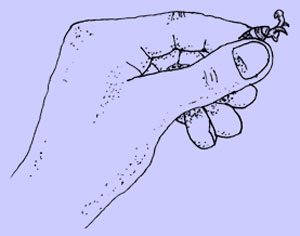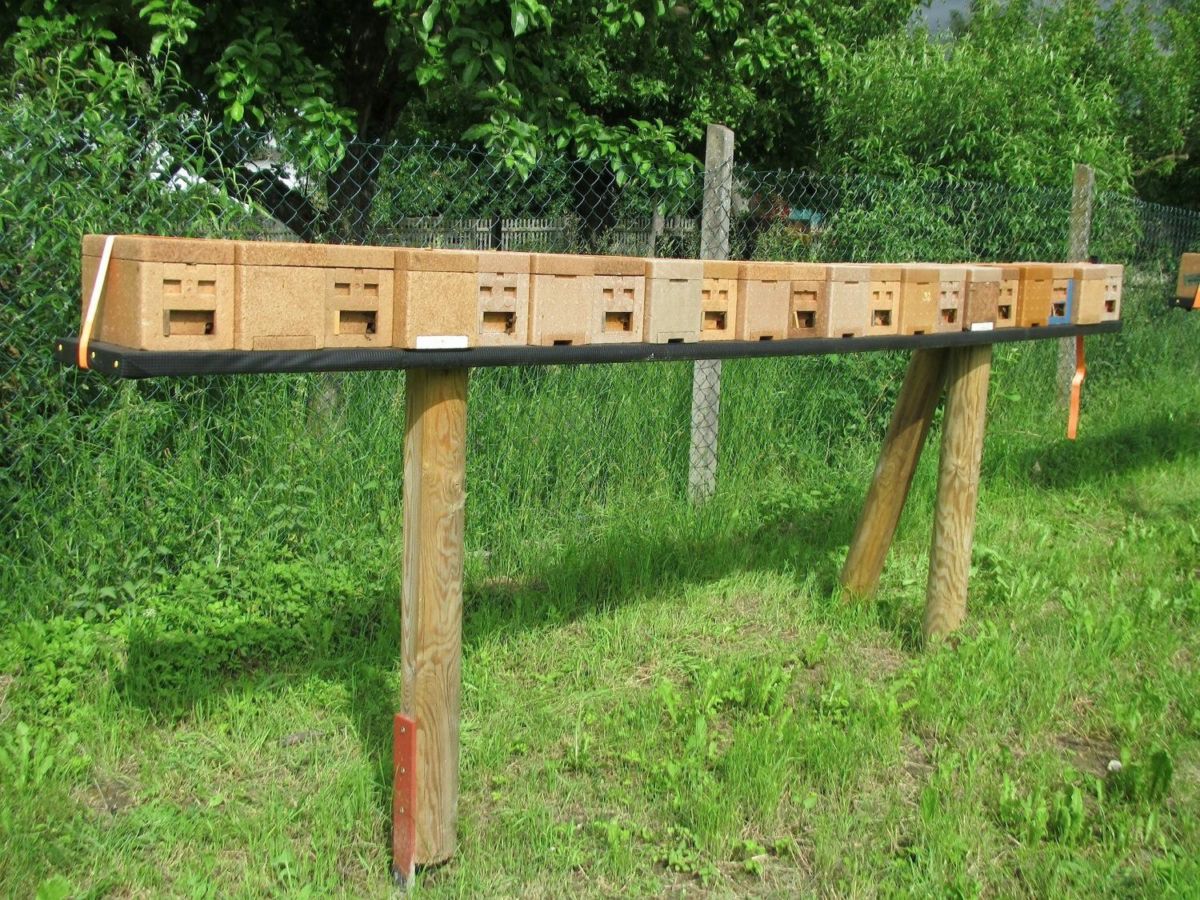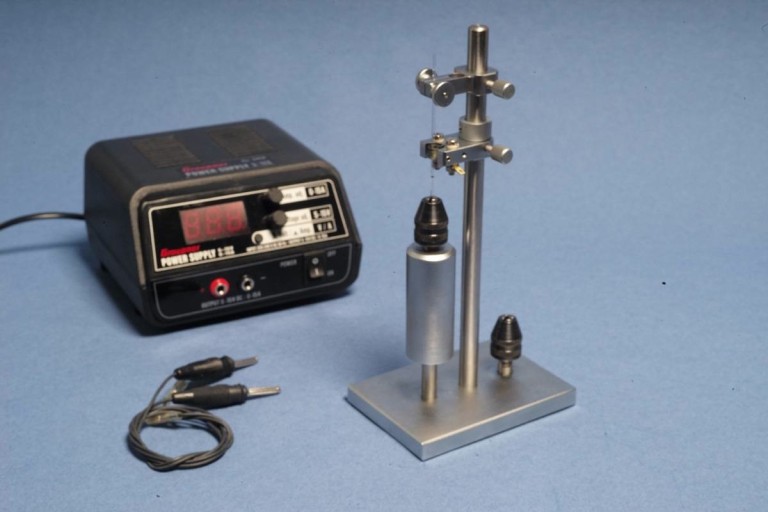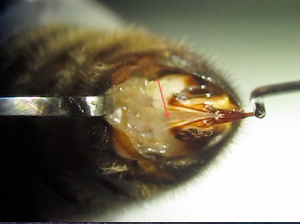Short Instructions to instrumental bee insemination
(The German part is described in more detail)
Drones and Queens
To obtain semen, drones should be at least 20 days or older and in healthy condition. The age of virgin queens and drones at the time of insemination is important as they must be sexually mature. Virgin queens should be 6 to 10 days old at the time of insemination. Queen inseminated younger than 5 days old have high mortality and queen inseminated after 14 days tend to store less sperm.
Eversion of Drones
Drones must be healthy and sexual mature to obtain semen. The drone is easily stimulated by hand in a two step process, [the partial eversion and the full eversion->eversion-of-drones]. A partial eversion is sometimes obtained by simply holding the drone by the head and thorax and teasing the abdomen. Further stimulation is usually necessary. Crush the head and thorax of the drone, holding this dorsally and ventrally. Sometimes it is also necessary to apply gentle pressure to the tip of the abdomen to stimulate the eversion. During partial eversion, the abdomen will contract and expose the cornua (horns) of the endophallus. Pressure should not be applied to the anterior or sides of the abdomen at this stage and care must be taken not to crush the abdomen.

The partial eversion must be completed to expose the semen.
To obtain the full eversion, apply pressure along the sides of the anterior abdomen with the thumb and forefinger. Squeeze the abdomen laterally starting at the anterior base of the abdomen and working toward the tip by rolling the fingers together in a strong and steady motion. This pressure forces the endophallas inside out to expose the semen. The semen is a creamy marbled color on a bed of white mucus. Take special care to avoid contamination of the semen.
Semen Collection
Before semen collection and between each drone draw a small air space followed by a small amount of saline solution to fill the taper of the glass tip. It is essential to separate the semen from the saline to prevent dilution of the semen.
Hold the ejaculated drone in your left hand and focus this near the syringe tip under the microscope. Expel the saline in the taper of the tip to make contact with the semen on the drone’s endophallas. Be sure to maintain the air space between the semen of the first drone and the saline. After making contact, skim the semen from the more [viscous mucus layer->semen-collection]. Avoid placing the tip of the syringe in the thick mucus layer. Care must be taken to avoid collection of mucus as this will plug the tip. To avoid drying of the semen at the tip, collect a small amount of saline in the tip of the syringe between drones.
Avoid the collection of air in the column of semen. Push out the air space and small amount of saline in the tip onto the semen of the next drone to make contact for collection. Repeat this process to collect the quantity of semen needed. Each queen should be given 8 microliters (= cubic millimeter) of semen or about 10 mm length in the glass-tip. This should take about 5 minutes to collect.
Placing the queen in the holder
Place the queen into the cylindrical backup tube. When she reaches the end of the tube with the small hole she will backup [into the holding->placing-the-queen-in-the-holder] tube held next to this. The holding tube with the queen fits on the queen holder of the instrument which is connected to the carbon dioxide line. The tube must be turned so that the back of the queen is on the right side. The queen is ready for insemination when she is motionless.
Opening the sting chamber
Both hooks may be used simultaneously to open the sting chamber of the queen. If the abdomen is tightly closed the ventral hook may initially be used. For the beginner, a pair of forceps can also be used to open the queen allowing [placement of the hooks->opening-the-sting-chamber].
Position the ventral hook by securing this in the natural small notch on the tip of the queen’s abdominal segment. The sting hook is then brought over and lowered to thread the sting. Now use the sting hook to lift the sting structure up and over to the right. When the hooks are properly positioned the tissue will stretch to form a large triangle. Within this triangle is a smaller „V“ of wrinkled tissue defining the vaginal orifice and location of the valve fold which is not readily visible. The vaginal orifice is located on the connecting line between the hooks. With some practice, the process takes only a few seconds. Beginners should appreciate to use the pressuregrip forceps to grasp the sting.
The opened sting-chamber
Collecting Semen
As seen from experience during insemination courses, there are two difficulties facing beginners despite all the advancements made: namely, obtaining semen from drones and the injection of sperm in the vaginal opening of the queen bee. Insertion of the insemination tip is considerably easier with use of the perforated hook I have invented, as well as by [using the pressure grip forceps->collecting-semen]. These have been developed based on practical experience. The techniques are more precise and easier to learn, yet initially require professional guidance and practice.
Preparation of the Queen Bee in the Holding Tube
Basically, the same type of technique is used worldwide to position the anesthetize the queen. To the right of the insemination device – from the inseminator’s point of view – there is a sting hook or mounted forceps (grasp from the queen’s posterior side), located to the left of the ventral hooks (hooks from the underbelly-side). With the help of these hooks, the sting chamber is opened and the vaginal opening is exposed for insemination.
The holding tube containing the queen and the insemination syringe must be properly aligned. The queen is positioned with her dorsal side to the right and abdomen protruding from the tube, several segments. If there is too much tension pulling to either side, the alignment is distorted and tissue looses elasticity. To prevent this and avoid overstretching, the ventral hooks is not pulled widely. It is very important to lift the sting area evenly.
The tip is moved to the right and slipped under the vavlefold, then moved slightly to the left to bypass the valvefold. The Tipp is inserted into the median oviduct, about 1mm.
Injection of semen
Each insemination should be preceded with a small amount of saline. After the syringe is filled with semen and between each insemination, collect a small air space and 2µl of saline. This acts as a lubricant, allows you to test if the syringe tip is properly positioned and prevents drying of the tissues.
The leading edge of the glass tip should be positioned above and to the right of the „V“ of wrinkled tissue. To bypass the valve fold a slight zig zag motion of the syringe tip is used. The tip is inserted 1/2 mm, then moved slightly left, increasing the incline of the tip and inserting this another 1/2 mm into the median oviduct. This is essential to move the valvefold to allow for passage of the semen.
The properly positioned syringe tip will [slip easily into the median oviduct->injection-of-semen], without movement of the surrounding tissue. The semen can now be injected and should not leak out. If the tissue moves with the syringe tip you have not bypassed the valve fold and the semen will back up. There should be no leakage of semen with a proper insemination.
Additional notes with instrumental insemination:
1 Ensure that when the queen is in the queen holder, at least 3 segments of the abdomen are exposed.
2 Check that the queen (and holding-tube) is fully in line with the syringe prior to any manipulations
3 The sting must be pulled to outside the body to allow the vaginal entrance to be properly exposed
4 Do again check and ensure that the queen is fully in line (axially and linearly) with the syringe tip. A slightly reduced (shallower) angle of attack can be tolerated
5 Make sure that there are no air bubbles in the syringe
6 When inserting the syringe tip ensure a maximum depth of no more than 2 mm (.1 inch)
7 To help with the vaginal entry , insert the tip approximately 0,5 mm, move the syringe tip slightly to the left (to overcome the bi-fold valve) and continue insertion for a further 0,5 mm (Assuming syringe is on right of II equipment)
8 After the sperm has been injected and prior to withdrawing, reduce the back pressure by sucking approx 0.5 to 1 micro litre using the syringe.
General additional notes
In general, any sperm collected should not remain at the end of the syringe tip, it should be withdrawn approx 1 mm and sealed with physiological solution (0.9% NaCl)
Instrumental Insemination is very delicate. In order to avoid vibrations and tiredness, rest the right hand elbow on the work surface when manipulating the syringe (assuming the syringe is in the right hand position)
Be very careful when operating the syringe, it is very easy to disturb the sting hook and to damage to the queen!
Videos
„[Collecting drone sperm->http://www.youtube.com/watch?v=iVjLkUVt-Lg/]“ and „[Insemination process->http://www.youtube.com/watch?v=3vPV_WeQxV8&feature=channel_video_title/]“ are two focal points.
Interesting perhaps are excerpts of our old IWF-video, see please: „[Artificial insemination->http://www.youtube.com/watch?v=W1_LhfK-VN4]“. The work is done with the SCHLEY-instrument 1.01.
Susan Cobey (Davis, USA) works with the instrument 1.01 and my old perforated hook. Excerpts from the video by Susan you’ll find at the following address:
Drone sperm collecting
The mature brown semen can be in different places. There was only one queen available at the end of the season. In the beginning, old sperm residues were removed.
In the following video you can see the new model and the pressure grip forceps 1.05:
Artificial insemination
Instrumental insemination classes





Dr. Schley explains the function of the syringe.

In the right foreground Mr. Wachholz. The rear left operated by his son the tip puller.

The SCHLEY puller manufactures disposal cannules.

